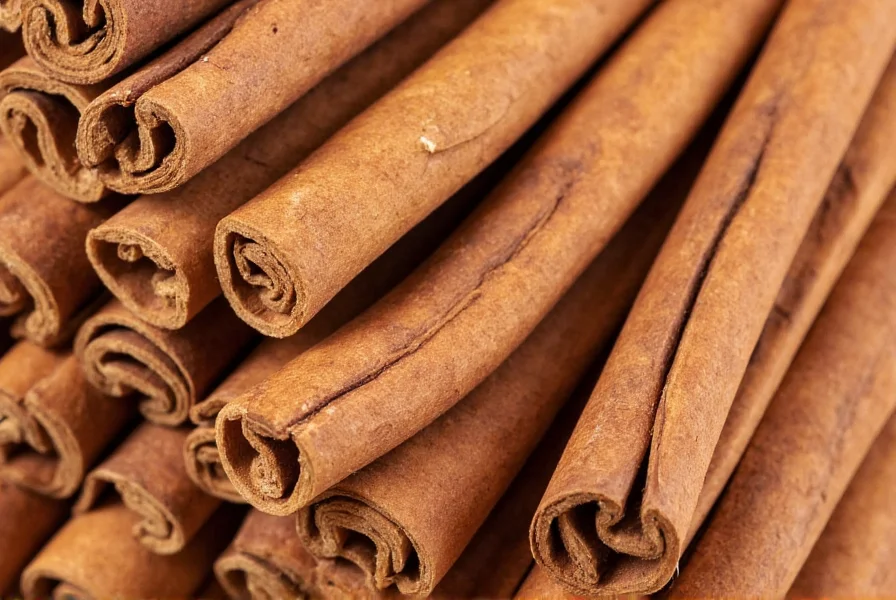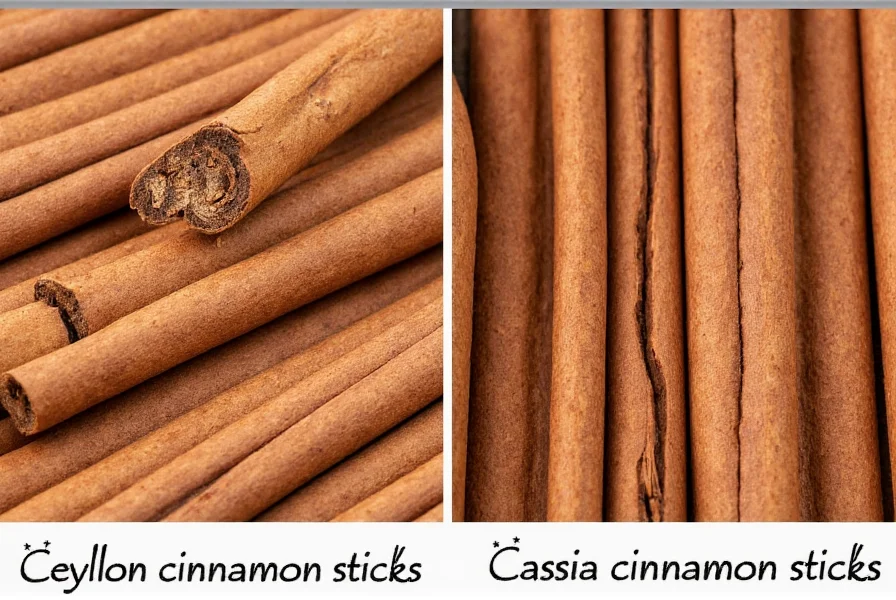When you reach for that spice jar, you're likely using one of two distinct cinnamon varieties that differ dramatically in flavor, appearance, and health implications. Understanding the difference between Ceylon and Cassia cinnamon matters not just for culinary precision but for your long-term health. While both offer the warm, comforting spice we love, their chemical compositions vary significantly, particularly regarding coumarin content—a compound that can cause liver damage when consumed excessively.
What Is Ceylon Cinnamon?
Native to Sri Lanka (formerly Ceylon), this “true cinnamon” represents only about 10-20% of the global cinnamon market. Ceylon cinnamon comes from the Cinnamomum verum tree and features multiple thin, delicate layers that form a tight, hollow tube. Its color ranges from light tan to pale brown, and it has a subtle, citrusy-sweet aroma that makes it prized in delicate desserts and beverages.

Culinary professionals prefer Ceylon cinnamon for dishes where a refined cinnamon flavor is desired without overwhelming other ingredients. It's particularly well-suited for custards, poached fruits, and Middle Eastern rice dishes. Because of its labor-intensive harvesting process and limited production, Ceylon cinnamon typically costs 5-10 times more than Cassia varieties.
What Is Cassia Cinnamon?
Cassia cinnamon, which accounts for approximately 90% of cinnamon sold in the United States and Europe, comes primarily from China (Cinnamomum cassia), though Indonesia and Vietnam also produce significant quantities. Unlike Ceylon's delicate quills, Cassia forms a single, thick, hard layer that's difficult to break. It has a darker reddish-brown color and delivers a more intense, spicy-sweet flavor profile that stands up well in robust recipes.
The stronger flavor of Cassia makes it the preferred choice for many commercial baked goods, cinnamon rolls, and spice blends like garam masala. Its affordability and bold taste have made it the default “cinnamon” in most supermarkets, though few consumers realize they're not getting the “true” variety. When examining a cinnamon stick, if it's hard to bend and consists of one thick layer, you're almost certainly holding Cassia.
Key Differences Between Ceylon and Cassia Cinnamon
| Characteristic | Ceylon Cinnamon | Cassia Cinnamon |
|---|---|---|
| Scientific Name | Cinnamomum verum | Cinnamomum cassia |
| Origin | Sri Lanka | China, Indonesia, Vietnam |
| Appearance | Multiple thin, soft layers; light tan color | Single thick, hard layer; dark reddish-brown |
| Flavor Profile | Mild, sweet, citrusy notes | Strong, spicy, intense |
| Coumarin Content | Approximately 0.017g per kg | Approximately 6.97g per kg |
| Price | Significantly more expensive | Affordable, widely available |
| Common Uses | Delicate desserts, beverages, Middle Eastern cuisine | Baked goods, spice blends, robust recipes |
Health Considerations: Why the Difference Matters
One of the most critical distinctions between these two cinnamon varieties involves coumarin, a naturally occurring compound that gives cinnamon its distinctive aroma but can be toxic to the liver in high doses. Cassia cinnamon contains up to 1,000 times more coumarin than Ceylon cinnamon. The European Food Safety Authority recommends a maximum daily intake of 0.1 mg of coumarin per kilogram of body weight.
For a 150-pound adult, this translates to no more than about half a teaspoon of Cassia cinnamon per day to stay within safe limits. Regular consumption of larger amounts—such as in cinnamon supplements or daily use in cooking—could potentially lead to liver damage over time. Ceylon cinnamon, with its minimal coumarin content, doesn't carry this risk, making it the safer choice for regular consumption or therapeutic use.
Both types offer potential health benefits, including blood sugar regulation, anti-inflammatory properties, and antioxidant effects. However, research suggesting cinnamon's health benefits often doesn't specify which variety was used, creating confusion about which type delivers the most benefit. Most clinical studies actually use Cassia due to its wider availability, despite its higher coumarin content.
How to Identify and Select the Right Cinnamon
Reading labels carefully is essential when shopping for cinnamon. In the United States, most grocery store cinnamon is Cassia unless specifically labeled as “Ceylon,” “True Cinnamon,” or “Cinnamon Verum.” Specialty spice shops, Latin American markets (where it's often called “canela”), and online retailers are your best sources for authentic Ceylon cinnamon.
When examining cinnamon sticks, look for these identifying features:
- Ceylon: Multiple thin layers that peel apart easily, light tan color, soft enough to be ground with a spice grinder
- Cassia: Single thick, hard layer that's difficult to break, dark reddish-brown color, often sold in chunks rather than complete quills

For ground cinnamon, identification becomes more challenging as the two types look nearly identical. Your best bet is purchasing from reputable spice companies that clearly label their products. If a cinnamon product seems unusually inexpensive, it's almost certainly Cassia.
Culinary Applications: Which Type Works Best
Understanding the flavor profiles helps determine which cinnamon variety works best in different recipes:
Ceylon cinnamon shines in:
- Delicate desserts like crème brûlée and panna cotta
- Light-colored sauces and custards
- Beef and lamb dishes in Middle Eastern cuisine
- Tea and other beverages where subtle spice is desired
- Recipes calling for children or those with liver concerns
Cassia cinnamon works best in:
- Robust baked goods like snickerdoodles and cinnamon rolls
- Spice blends such as pumpkin pie spice and garam masala
- Stews and braises with strong flavors
- Recipes where cinnamon should dominate other spices
- Occasional use where coumarin intake isn't a concern
When substituting one for the other, remember that Cassia's stronger flavor means you'll typically need less—about 75% of the amount called for when replacing Ceylon with Cassia. Conversely, when substituting Ceylon for Cassia, you might need to increase the amount by 25-50% to achieve similar flavor intensity.
Making an Informed Choice
For most home cooks, having both types of cinnamon available provides maximum culinary flexibility. Keep Cassia for everyday baking where its bold flavor works well, and reserve Ceylon for special occasions, delicate dishes, or when preparing cinnamon for regular consumption. Those with liver conditions, pregnant women, or individuals taking medications metabolized by the liver should opt for Ceylon cinnamon to avoid potential coumarin-related complications.
As awareness grows about the differences between these two cinnamon varieties, more retailers are beginning to specify which type they sell. This transparency helps consumers make informed choices based on both flavor preferences and health considerations. Whether you're sprinkling it on your morning oatmeal or incorporating it into a complex curry, understanding the two types of cinnamon empowers you to use this ancient spice more effectively and safely.
What's the main difference between Ceylon and Cassia cinnamon?
The primary differences are in appearance, flavor, and coumarin content. Ceylon cinnamon has multiple thin layers, a lighter color, milder flavor, and significantly lower coumarin levels. Cassia cinnamon forms a single thick layer, has a darker color, stronger flavor, and contains much higher levels of coumarin, which can be harmful in large quantities.
Is Cassia cinnamon dangerous to consume?
Cassia cinnamon isn't dangerous when consumed in moderation. The concern is with regular, high consumption due to its coumarin content. For most adults, consuming more than about half a teaspoon of Cassia cinnamon daily over extended periods could potentially cause liver issues. Occasional use in baking or cooking presents minimal risk for healthy individuals.
How can I tell if my cinnamon is Ceylon or Cassia?
Examine the cinnamon sticks: Ceylon forms multiple thin, soft layers that peel apart easily and has a light tan color, while Cassia forms a single thick, hard layer that's difficult to break and has a dark reddish-brown color. For ground cinnamon, check the label carefully as they look nearly identical. Reputable brands will specify which type they sell, and Ceylon is typically more expensive.
Which type of cinnamon is better for blood sugar control?
Both types may offer blood sugar benefits, but research is inconclusive about which is more effective. Most clinical studies on cinnamon and blood sugar have used Cassia due to its wider availability, despite its higher coumarin content. For regular therapeutic use, many health professionals recommend Ceylon cinnamon because of its safety profile, though it may be slightly less potent for blood sugar regulation.
Where can I buy authentic Ceylon cinnamon?
Authentic Ceylon cinnamon is available at specialty spice shops, Latin American markets (where it's often labeled as “canela”), Middle Eastern grocery stores, and reputable online spice retailers. Look for labels specifying “Ceylon,” “True Cinnamon,” or “Cinnamomum verum.” Be prepared to pay a premium price, as genuine Ceylon cinnamon typically costs 5-10 times more than Cassia varieties.











 浙公网安备
33010002000092号
浙公网安备
33010002000092号 浙B2-20120091-4
浙B2-20120091-4